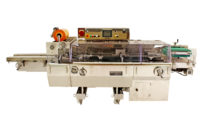Announced some five years ago, the revolution to be initiated by Industry 4.0 has failed to materialise so far. Instead, it appears that the digital transformation is taking place in numerous small evolutionary steps. The direction being taken is already shown by a wide range of applications from the fields of product and processes monitoring, labeling technology, packaging, distribution, logic, servicing and maintenance, whereby the main players are software, sensors, data and networking.
Industry 4.0 needs innumerable IP addresses
In future, machines and plant will not only supply independent information about the condition of all important processes and systems but also communicate with each other and intervene in production processes to correct and optimise them without any human input. This calls for innumerable interlinked high-performance sensors to monitor product, machine and process data. However, the previous internet protocol, IPv4, cannot supply the huge number of IP addresses required for this. Therefore, the most urgent task is the rapid conversion to the new internet standard, IPv6, which is capable of providing an almost infinite number of IP addresses for sensors, devices, machinery and plant. This changeover is currently taking place all around the globe.
Networked sensors are the key
Sensors with direct or wireless network connections, as well as data loggers, are increasingly being used for measuring the temperature, humidity, viscosity, electricity consumption, torque, pressure, material flow, weight, etc., whereby RFID (Radio Frequency Identification) technology stands out in this connection. RFID tags exchange information and signals wirelessly with the read/write devices of the various processing machines and the transport, refrigeration and storage systems. Integrated into everything from slaughtering hooks and transport cradles to containers, E2 meat crates or packaging, they can control machinery and plant, not to mention register all product and process conditions along the value chain. Available at all times, the process data provide for greater production transparency, control and efficiency and represent a reliable stock of information for manufacturers with regard to the traceability of products and batches.
Labelling technology for transparency and safety
Intelligent and flexible labeling systems are essential for processing, packaging and logistics, including the storage of meat and sausage products whereby, in accordance with EU Directive 1169/2011, the focus is on information about the appellation of the product, the country or place of origin, the slaughter house, individual series and batch numbers, as well as details of ingredients, nutrition declarations, net weights, the freezing date of meat and meat products, etc. Laser, inkjet and thermal printers have become standard equipment for printing labels with bar, data matrix or QR codes while laser scanners and digital cameras ensure that the labels are printed and positioned correctly. Also of particular interest in this connection is RFID technology that, in distinction to the other processes, requires no clear line-of-sight connection to write or read data. Thus, RFID tags can be attached anywhere on the E2 meat crates or other transport containers, which simplifies the entire handling side (transport, palletising, storage, etc.) and makes the whole process significantly more reliable by, for example, avoiding incorrect storage.
Machine operation changing
The demands on the operability of systems increase with the growing complexity and interlinkage of production, processing and packaging lines, and touchscreens with functions similar to those to be found on smartphones and tablet PCs are rapidly becoming standard. They offer simple, safe and, above all, intuitive operation because most people are familiar with the basic operating commands from their communication devices. Vital for the working ergonomics in this case are the design of the user interface with self-explanatory symbols and photo-realistic illustrations of the machines and plant on the process line. In a subsequent stage, the stationary systems are likely to be replaced by mobile operating devices. However, there are still many questions to answer with regard to machine, product and data safety and security, as well as obligatory standards.
Plant availability and production safety and security
Unscheduled production stops are a nightmare for every manufacturer. Networked sensors for machine monitoring (condition monitoring (CMS)) in connection with intelligent data analysis and integration in ERP systems provide an opportunity for predictive maintenance (PM). This can also take place within the framework of a remote-maintenance agreement with the machine or plant manufacturer, which can reduce service costs and increase not only production quality but also make planning more reliable.
The next IFFA – The No. 1 for the meat industry – opens its doors in Frankfurt am Main from 7 to 12 May 2016. There, trade visitors have the opportunity to gather in-depth information about networking machines and processes using modern information, sensor and control technology in accordance with the principles of Industry 4.0. Around 960 exhibitors from 47 countries, including all market leaders, will present their innovations along the entire process chain of the meat industry.
Detailed information about IFFA 2016 can be found at: www.iffa.com








